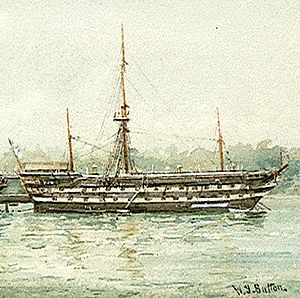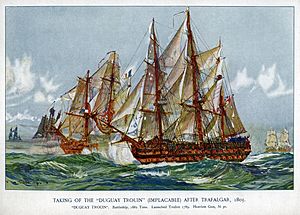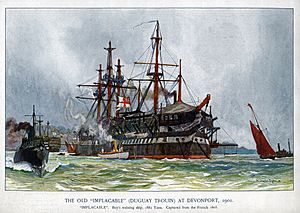HMS Implacable (1805) facts for kids

Implacable in 1894, by W. J. Sutton
|
|
Quick facts for kids History |
|
|---|---|
| Name | Duguay-Trouin |
| Laid down | 1797 |
| Launched | Rochefort, 24 March 1800 |
| Honours and awards |
|
| Captured | 3 November 1805, by Royal Navy |
| Name | HMS Implacable |
| Acquired | 3 November 1805 |
| Renamed | Foudroyant in 1943 |
| Honours and awards |
|
| Fate | Scuttled 2 December 1949 |
| General characteristics | |
| Class and type | Téméraire-class ship of the line |
| Tonnage | 3,223 tons (as measured from 1882) |
| Tons burthen | 1,896 22⁄94 bm |
| Length | 181 ft 6 in (55.3 m) |
| Beam | 48 ft 11 in (14.9 m) |
| Depth of hold | 20 ft 7 in (6.3 m) |
| Sail plan | Full-rigged ship |
| Complement | 640 officers and crew |
| Armament |
|
HMS Implacable was a 74-gun third-rate ship of the line of the Royal Navy. This type of ship was a large sailing warship. She was originally the French Navy's Duguay-Trouin, launched in 1800.
She survived the famous Battle of Trafalgar but was later captured by the British at the Battle of Cape Ortegal. As a British ship, Implacable helped capture the Russian ship Vsevolod in the Baltic in 1808 during the Anglo-Russian War. Later, Implacable became a training ship for young sailors. She eventually became the second oldest ship in the Royal Navy after HMS Victory, which was Lord Nelson's flagship at Trafalgar. When the Royal Navy finally sank Implacable in 1949, she proudly flew both the French and British flags side-by-side as she went down.
Contents
Duguay-Trouin: Her French Story
The ship was first named Duguay-Trouin after a famous French sailor, René Trouin, Sieur du Gué. Her construction started in 1794 but was paused for a while. She was finally built and launched in Rochefort, France, in 1800.

In 1802, under Captain Claude Touffet, Duguay-Trouin sailed from Toulon as part of a small group of ships. They were heading to Santo Domingo but got stuck in Cap Français because British ships were blocking the port. After a daring escape in the dark, Duguay-Trouin and another ship got away.
On October 21, 1805, Duguay-Trouin took part in the huge Battle of Trafalgar. She was one of only four French ships that managed to escape capture that day.
Capture by the British
On November 3, 1805, a British fleet led by Captain Sir Richard Strachan caught up with the remaining French and Spanish ships. In this battle, the captain of Duguay-Trouin, Claude Touffet, was killed. Her masts were destroyed, and she was finally captured by the British.
Implacable: Her British Story
The Royal Navy took the captured ship and renamed her HMS Implacable. She then served with the British Navy for the rest of the Napoleonic Wars.
Battles in the Baltic Sea
In 1808, Russia started a war with Sweden. Britain decided to help Sweden and sent a fleet to the Baltic Sea. Implacable, commanded by Captain Thomas Byam Martin, was part of this fleet.
On August 26, 1808, Implacable caught up with a Russian ship called Vsevolod. Implacable and Vsevolod fought for about 20 minutes. Vsevolod eventually lowered her flag, meaning she surrendered. However, the rest of the Russian fleet was getting close, so Implacable had to pull back.
A Russian frigate tried to tow Vsevolod away, but another British ship, Centaur, chased them. Centaur crashed into Vsevolod, and both ships got stuck. Implacable then joined the fight. After about half an hour, Vsevolod surrendered again.
The British took the prisoners and wounded sailors off Vsevolod. Because the Russian ship was badly damaged and stuck, the British decided to burn her. Vsevolod exploded hours later. This battle was the biggest fight during the Anglo-Russian War.
Raids and Rescues
In the summer of 1809, Implacable was back in the Baltic. She and another ship, Melpomene, sailed into the Gulf of Narva. There, they captured nine ships carrying wood and supplies that belonged to the Russian Emperor.
The British then found a group of Russian ships hiding near Percola Point, protected by eight gunboats. Each gunboat had powerful cannons and a crew of 46 men. The British decided to send a small group of boats to capture them.
On July 7, 1809, 17 British boats, led by Lieutenant Joseph Hawkey, attacked. The Russians were ready and aimed their cannons at the British. The British boats rowed straight in, taking fire without shooting back, until they reached the Russian gunboats. They then boarded the enemy ships.
The British captured six of the eight gunboats and sank one. They also captured 12 supply ships that the gunboats were protecting. The British had heavy losses, with 17 men killed and 37 wounded, including Lieutenant Hawkey. The Russians lost many more. This brave action earned the British sailors a special medal.
Helping Spain
In 1810, Implacable sailed to Quiberon Bay to help free Ferdinand VII of Spain, who was imprisoned by the French. The mission didn't work, but Implacable continued her service.
Later, Implacable went to Cádiz, Spain, to help defend the city from a French army siege. She helped transport troops and supplies. In August, Implacable supported a successful attack by Spanish troops against the French at Moguer.
In 1811, Implacable sailed to Mexico to pick up a large amount of money (2 million dollars) and brought it back to Cádiz. She continued to help defend the area until 1813, when she returned to England.
After the Wars
From August to November 1840, Implacable took part in the attack and capture of Acre and other operations along the coast of Syria. Sailors who participated in this campaign later received medals.
After this, Implacable spent about a year in the Mediterranean Sea. By 1842, she was in Devonport, England, and was considered too old for active sea service.
A Training Ship
From 1844, Implacable was out of service. However, she was converted into a training ship for boys in 1855. She helped teach young sailors about life at sea. In 1908, King Edward VII stepped in to save the ship from being scrapped. In 1912, she was given to a kind person named Geoffrey Wheatley Cobb to be preserved and used as a training ship for boys.
Over the years, there were many efforts to raise money to restore Implacable. She served as a place for sailors to live, a training ship, and even a holiday ship. In 1943, she and another ship were renamed Foudroyant.

Her Final Journey
Implacable survived Second World War. However, on December 2, 1949, the Navy decided to sink her using explosives. A special boat towed her to a deep spot east of the Isle of Wight. She sank into the sea, about five miles from Ventnor.
Many people protested against sinking Implacable because she was the second-oldest ship in the Navy after Victory. But after the war, Britain was facing tough times, and the cost to restore her was too high. In 1947, they even offered her to the French, but they also couldn't afford to turn her into a museum.
Even though the ship was sunk, some important parts were saved. Her figurehead (the carving on the front of the ship) and parts of her stern (the back of the ship) are now on display at the National Maritime Museum in Greenwich. Her capstan (a machine used to pull ropes) is at the maritime museum in Rochefort, France. The doors to the Captain's cabin are in the museum ship HMS Unicorn in Dundee. The public's strong reaction to Implacable's sinking helped convince the government to support saving the famous ship Cutty Sark.
Images for kids
-
The stern gallery of HMS Implacable, formerly the Duguay-Trouin, on display at the National Maritime Museum.






